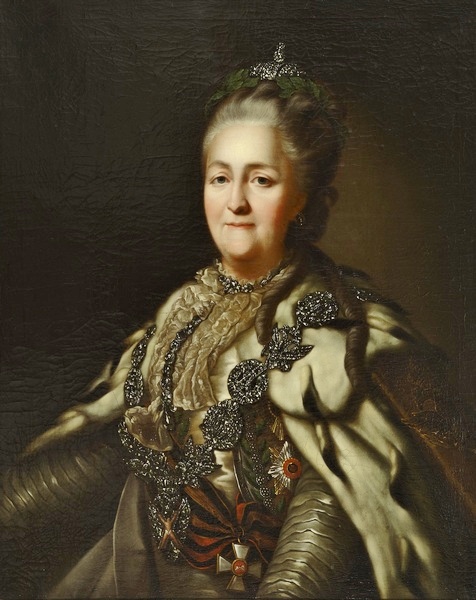She was supposed to have been married off to provide an “heir and a spare.” She came to power in a coup d’état that she organized and carried out. She made her country stronger, expanded its borders, and made it one of the great powers of Europe.
Sophie Friederike Auguste von Anhalt-Zerbst was born on May 2, 1729, in Prussia to a minor prince. When Sophie was 15-years old, Czarina Elizabeth of Russia, one of Peter the Great’s daughters, invited her to Russia. Elizabeth was childless, but had chosen her nephew, Charles Peter Ulrich of Schleswig-Holstein-Gottorp, as heir. He needed a wife.
Sophie, who had been trained by her mother, made an impression on Elizabeth. Sophie took on the name, Ekaterina, or Catherine, assumed the title of Grand Duchess Catherine Alekseyevna, and married Peter on Aug. 21, 1745.
She had all the right manners and knew how to behave, but it was eight years before Catherine produced an heir. The fault, some historians believe, was with her husband who either could not consummate the marriage or was infertile.
According to Encyclopedia Britannica, “He was extremely neurotic, rebellious, obstinate, perhaps impotent, nearly alcoholic, and, most seriously, a fanatical worshipper of Frederick II of Prussia, the foe of the empress Elizabeth. Catherine, by contrast, was clearheaded and ambitious. Her intelligence, flexibility of character, and love of Russia gained her much support.”
The couple were unhappy with each other, leading to affairs. Catherine was having an affair with Sergei Saltykov when she gave birth to Paul. Many believed Sergei to be the father.
Catherine herself gave credence to this rumor in her memoirs, going so far as to say that Empress Elizabeth had been complicit in permitting Catherine and Saltykov’s relationship. While historians today believe that Catherine’s claims were simply an attempt to discredit Peter and that he was indeed Paul’s father, there is little debate over the paternity of Catherine’s three additional children: It’s believed that none of them were fathered by Peter.
When Elizabeth died on January 5, 1762, Peter became Peter III. He ended the war with Prussia, angering the military. He installed domestic reforms to improve the lives of the poor, something the lower nobility disagreed with.
The nobility and the military approached Catherine. She had public support. The intellectuals supported her. The enlightened parts of the aristocracy supported her.
She mounted a plan to overthrow her husband. In July 1672, her plans were discovered, but, being a shrewd leader, she quickly gained the military’s support and had Peter arrested.
Peter was forced to abdicate on July 9. His short-lived reign lasted six months. Catherine became Empress of Russia. Though there was no bloodshed during the coup, Alexei Orlov, brother of Gregory, Catherine’s lover, murdered Peter on July 17. There is no evidence Catherine knew of her lover’s plans, but it was not the ideal way to start a reign.
Catherine continued the work Peter the Great had started – expanding Russia and westernizing her adopted country.
During her reign she extended the Russian empire southwards and westwards, adding territories which included the Crimea, Belarus and Lithuania. Agreements with Prussia and Austria led to three partitions of Poland, in 1772, 1793, and 1795, extending Russia’s borders well into central Europe.
This was important because she had inherited an empty state treasury. She sorted the problem by “secularizing the property of the clergy, who owned one-third of the land and serfs in Russia.”
Early in her reign, Catherine was known as a reformer. As an enlightened woman, she desired order and justice. She sought out educational reforms.
She wrote books, pamphlets, and educational materials in an effort to improve Russia’s education system. She supported the arts. She wasn’t just a supporter of the arts. She even created her own opera.
One of her biggest accomplishments was the creation of the now famous Hermitage Museum. It is one of the world’s premier art collections housed in St. Petersburg’s Winter Palace.
She corresponded often with thinkers, such as Diderot and Voltaire, who she kept in touch with her entire life.
Catherine was not able to put all of her ideas of reform into practice. What barely worked in France with Montesquieu and Jean-Jacques Rousseau did not work in Russia. The country was too backwards so Catherine tried something else.
In 1767 she convened a commission composed of delegates from all the provinces and from all social classes (except the serfs) for the purpose of ascertaining the true wishes of her people and framing a constitution. The debates went on for months and came to nothing. Catherine’s Instruction to the commission was a draft of a constitution and a code of laws. It was considered too liberal for publication in France and remained a dead letter in Russia.
Catherine then had a series of unfortunate defeats. She went to war with the Ottoman Empire. In 1770, she achieved a naval victory at Çeşme, but Turkey was not defeated. A plague broke out in Moscow and the people were tired of war.
During her reign, Catherine survived more than a dozen uprisings and threats to her regime.
the most dangerous came in 1773, when a group of armed Cossacks and peasants led by Emelyan Pugachev rebelled against the harsh socioeconomic conditions of Russia’s lowest class, the serfs. As with many of the uprisings Catherine faced, Pugachev’s Rebellion called into question the validity of her reign. Pugachev, a former army officer, claimed that he was actually the deposed (and believed dead) Peter III, and therefore the rightful heir to the Russian throne.
Pugachev’s claims were considered a joke at the time, but, a year later, he had gained enough support that Catherine no longer ignored the situation. Catherine threw so much military might at Pugachev, his supporters ran away, abandoning him to his fate. He was arrested and publicly executed in January 1775.
Russia eventually defeated Turkey, but Catherine still had several negatives to deal with at home.
Ninety-five percent of Russia was agricultural-based, but she had to abandon her desire to emancipate the serfs. She relied too much on the support of the nobility to anger them. She turned on her ideals and imposed serfdom on Ukraine, which had been free, and distributed their lands to her friends. She ended up with more legal control of serfs, which made their lives worse than at the beginning of her reign. Their work supported her other projects, which made people admire her.
Catherine never married again after the death of Peter, choosing lovers instead. She had two more children during her life and several more lovers.
She became involved with Stanisław Poniatowski, one of her earliest lovers and the father of one of her children, before she came to the throne. They ended their relationship when he was forced to leave court, but the two remained friends. She helped him to become king of Poland, but, the relationship soured when Stanislaw decided he wasn’t going to be a Russian puppet. He wanted Polish independence. She forced him to abdicate.
Catherine became involved with Grigory Potemkin in 1774 after the defeat of Turkey. Grigory made a name for himself during the war and Catherine began to mix business with pleasure. Previously, her ministers were chosen for their ability to do the job. She found Grigory had the ability to satisfy that requirement as well as her personal desires.
Though their personal relationship lasted two years, Catherine seemed to agree with his grandiose ideas for what Russia could be. He remained a friend and confidante.
The Crimea was annexed. Alliances with Prussia and England were ended. The alliance with Austria was renewed.
Catherine’s glorification reached its climax in a voyage to Crimea arranged by Potemkin in 1787. In a festive Arabian Nights atmosphere, the empress crossed the country to take possession of her new provinces; the emperor of Austria, the king of Poland, and innumerable diplomats came to honour her and to enjoy the splendours of what became known as “Cleopatra’s fleet” because Catherine and her court traveled partly by water. She dedicated new towns bearing her name and announced that she ultimately intended to proceed to Constantinople.
Then, the French Revolution happened. Catherine felt threatened and there was no way she was going to give up her power. When Poland threatened to do the same as France, Catherine decimated it, dividing the country between Russia, Prussia, and Austria in 1795.
Though her reign was extraordinary, her death the day after a stroke was ordinary. Her enemies spread stories about how she died, including on the toilet. Her lifelong love of horses, however, is the enduring myth of how she died. The rumor of Catherine dying while having sex with a horse was too much for the populace to keep to themselves. It was such a widespread rumor, that it continues to be told today.
Her reign lasted 34 years. Russia continues to exhault her. She ruled harshly and expanded the borders of her country. She built new towns and fixed the old ones. She expanded trade and communications. She was loyal to her friends and showed mercy to her enemies.
She was a patron of literature and a promoter of Russian culture; she herself wrote, established literary reviews, encouraged the sciences, and founded schools. Her interests and enthusiasms ranged from construction projects to lawmaking and the collection of art objects; she touched on everything, not always happily but always passionately. She was a woman of elemental energy and intellectual curiosity, desiring to create as well as to control.
She was Catherine the Great.


Judith A Chaloupka
I have always been fascinated by Catherine The Great! Thanks.